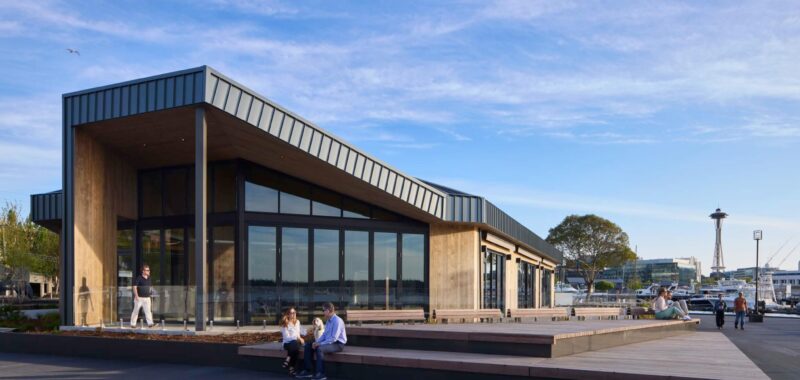Smack dab in the middle of Seattle is a freshwater lake known as Lake Union. The South Lake Union neighborhood has lived multiple lives: It was originally home to the Duwamish Indigenous people but morphed into an industrial region full of lumber mills and gas plants after white settlement from the 19th century on to the 1980s. Today, it has again shifted as the city transitions toward more sustainable living and working. The community, and Lake Union itself, is now encircled by green infrastructure like parks and pedestrian paths. Among these improvements is the renovated Lake Union Piers project by local firm Miller Hull. Its completion marks the firm’s first project completed under its EMission Zero initiative.
Lake Union Piers is a recreation spot located along the southern portion of Lake Union. Miller Hull renovated three 1980s industrial structures spanning 5 acres to allow local restaurants, entertainment, and retail to flourish within this public maritime hub. In between the buildings is an open plaza and along the waterfront is a promenade where people sit and take in the surrounding shoreline scenery.

Since its founding in 1977, Miller Hull has designed with a sustainable edge. The newest green initiative, EMission Zero, launched in 2021 with the goal of eliminating greenhouse gas emissions in all Miller Hull projects. “EMission Zero has four components for Miller Hull: Design, Educate, Advocate, and Offset,” principal Jim Hanford told AN. “The idea is that the project team—owner, contractor, and designer—works together to reduce or eliminate both future operational emissions (from building energy use) and embodied emissions (from construction).” For the Lake Union Piers project, Miller Hull collaborated with the owner, Vulcan Real Estate; and contractor, Abbott Construction. Fortunately, all parties agreed to participate in EMission Zero, and each offset one-third of the Lake Union Piers’ A1-A3 emissions.
Lake Union Piers includes three buildings that were completely renovated to match both EMission Zero standards along with Seattle’s current Energy Code. Miller Hull senior associate Cory Mattheis provided insight into how the design team used a “subtractive” process for the design. “The subtractive approach to making space came from very pragmatic reasoning. The existing buildings were constructed in 1986, at a time when shoreline setbacks and environmental concerns were different,” Mattheis explained. “Faced with this challenge, we decided that carving away at the existing massing was the best way to redefine the language of the project while providing necessary relief to the previously hardened perimeter.”

The three buildings exhibit unique geometric shapes that are wrapped in warm wooden shiplap vertical panels by Kebony and dark metal roofing by AEP Span that extends to the sides of the buildings. Renovating the three existing structures rather than building from the ground up was a crucial step to hit EMission goals. Hanford noted that reusing the existing structures, along with the wooden frame and concrete foundation, helped immensely with meeting the sustainable goal through its low embodied emissions.


“To us, this project represents a way for architects to embrace the value of existing buildings rather than always turning to new construction as the answer,” Hanford said. In a way, Lake Union Piers mirrors the surrounding area by also living multiple lives—but this time, with an environmental grasp that is here to stay.

